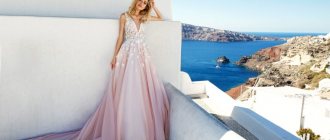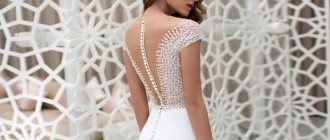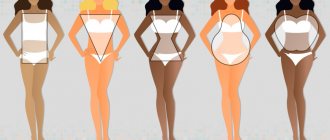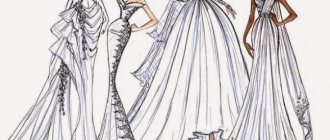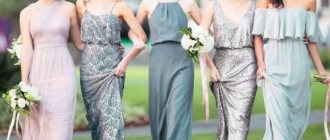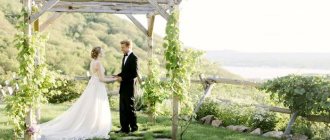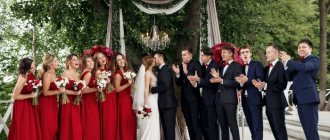Not only the beauty of the wedding dress, but also the comfortable state of the bride during the celebration depends on the choice of fabric. When sewing your own dress for the ceremony, the issue of selecting materials becomes even more relevant.
Wedding dresses from various fabrics
Some fabrics are easy to process, while some are difficult for even experienced seamstresses to handle. Therefore, the final result of the work often depends on the choice of material. What fabric are wedding dresses made from? The following materials are considered the most suitable:
- tulle;
- silk;
- atlas;
- guipure;
- chiffon;
- crinoline;
- jacquard;
- linen;
- tulle;
- brocade;
- organza;
- taffeta.
Taffeta wedding dress
The last three types are most often used for sewing dresses that are worn for autumn and winter ceremonies. Dividing fabrics according to the degree of protection from cold is the simplest and roughest way of classification. After all, each of the listed varieties has unique density, elasticity, texture and other properties.
Tulle wedding dresses
Tulle is a light and soft material with a mesh structure . It is not for nothing that the name of the material for a wedding dress is consonant with the main element of the bride’s image - the veil is most often sewn from this fabric. Tulle is also almost ideal for making wedding dresses - it is lush and voluminous, but easy to process.
Tulle wedding dress
Initially, the raw materials for this material were natural fibers, but with the development of the textile industry, nylon and polyester became its basis.
Tulle made from synthetic fibers is superior to its natural predecessor in many respects: stiffness, elasticity, volume
Thanks to these qualities, it is easy to mold lush wedding hem designs from it.
Tulle is valued by almost all designers and fashion designers for its variety of products. On sale you can find varieties with shiny and matte textures, with various decorations: sparkles, sequins, patterns, embroidery, colored coating, etc.
Lush tulle bridesmaid dress
Famous designer Vera Wang, for example, calls tulle one of her favorite materials. Almost every wedding collection of hers contains many magnificent dresses made from this fabric.
Silk wedding dress
Photo of a bride at a wedding in a dress made of natural silk.
Only well-to-do brides can afford a silk dress. After all, natural silk is the most luxurious and expensive fabric. And this despite the fact that it has certain disadvantages:
- silk wrinkles easily, wide dresses made from it quickly acquire a sloppy appearance;
- fitted models look neat, but focus attention on the flaws of the figure;
- Silk fabric is difficult to work with, it constantly slips and slides;
- When sewing a silk dress, any mistake can result in significant financial expenses, since the fabric is delicate and expensive.
Despite all the shortcomings, silk continues to be the most desirable and in demand material among rich brides.
It is incredibly pleasant to the touch, suitable for girls with any skin type and is not capable of causing irritation. The bride's image is luxurious and elegant; silk dresses complement it with femininity and airiness.
Silk wedding dress
Main options
The most popular fabrics for wedding dresses are:
- silk;
- atlas;
- crepe;
- chiffon;
- organza;
- taffeta;
- brocade;
- velvet.
Sometimes they are combined with each other, creating a unique image. Each material has both advantages and disadvantages.
Guipure wedding dress
Guipure is a translucent fabric with a relief openwork pattern. It is also called Venetian lace. The material is light and thin, so it is rarely used on its own. It is usually used as an additional fabric for lace finishing of cotton, chiffon, linen and other surfaces.
Photo of the bride in a dress with guipure top
Sometimes the main material is guipure, in which case certain places are “insulated” with lining. Some very brave brides wear a tight-fitting guipure dress without lining for their wedding, which clearly shows off their figure. This outfit looks feminine, mysterious and even elegant. But only girls with an ideal physique can afford it .
It is easy to choose accessories and jewelry for a guipure dress. Since the fabric itself looks elegant, the image will not tolerate an overabundance of additional decorative elements. But a small amount of elegant gold jewelry will decorate it as harmoniously as possible. Here lies the disadvantage of guipure - it is very “picky”; costume jewelry and other economical options do not go well with it. Only real jewelry.
Cutout shape
- • Open neckline without straps. This type is one of the most popular and diverse. It can be straight, with a bend, or in the shape of a heart. Well suited for brides with small or medium breast size.
Save Saved
Save Saved
Save Saved
- • Halter/stand collar. This type of neckline features a high neckline, large armhole and open shoulders. A dress with such a neckline looks great on tall girls and is suitable for those with broad shoulders and a sporty figure.
Save Saved
Save Saved
Save Saved
- • V-neck. The line of this neckline follows the shape of the letter V, creating a deep neckline. This style is suitable for girls with medium breast size; Lush or, conversely, small breasts will not look very good in such a neckline.
Save Saved
Save Saved
Save Saved
- • "Boat". The line of this neckline coincides with the line of the collarbone and runs from the top of one shoulder to the other with minimal curve. Thus, the neckline area is almost completely covered. Modest, but solemn.
Save Saved
Save Saved
Save Saved
- • Portrait cutout. This type of neckline is similar to the previous one. But unlike the “boat”, here the upper part of the neckline is trimmed with embroidery, rhinestones and other decorative elements, which creates an emphasis on the upper part of the dress.
Save Saved
Save Saved
Save Saved
- • Asymmetrical (on one shoulder). It looks very unusual and is perfect for an urban wedding. By the way, wedding suits and overalls look especially advantageous with an asymmetrical neckline.
Save Saved
Save Saved
Save Saved
Chiffon wedding dresses
Chiffon dresses are one of the best tools for creating a feminine and romantic look. But this is what you need for a wedding! Therefore, chiffon wedding dresses are not uncommon in modern fashion.
Photo of a chiffon dress for a wedding
This fabric is light, translucent, and is often used as an addition to other materials.
Chiffon is traditionally used for sleeves, bodice trim, and veil.
Working with it is a pleasure; the pliability of the fabric allows you to create the most complex draperies for lush wedding hems.
The raw materials for making chiffon can be both natural and synthetic fibers. But in any case, it provides good air exchange and is very comfortable in extreme heat.
Chiffon wedding dress
The fabric folds easily and compactly; there are usually no problems with storing a wedding dress made from it. Of course, we are talking about single-layer models in the Greek style, which can easily fit even into a shoe box.
General style
Classic
A traditional wedding implies a classic image of the bride - a dress with a full skirt, heels, and a veil. This is the case when a “ballroom” style and a long train, luxurious trim, and lace are appropriate. The color is also assumed to be classic white, shades of champagne and ivory are acceptable.
Save Saved
Save Saved
Save Saved
Romance
An option for a slightly less formal celebration, but still maintaining solemnity and elegance. It is better to abandon the ballroom style in favor of an A-line silhouette and flowy fabrics, but it is still recommended to choose the classic length for a wedding dress - floor-length. Any delicate shades will be appropriate: from nude to dusty rose.
Save Saved
Save Saved
Save Saved
boho
Fluffy dresses, rhinestones, satin, corsets, and bright color accents are not suitable for a boho look. The dress should be loose, light, summer. Lace, ethnic elements, and long sleeves would look appropriate. The colors of the dress in boho style are pastel: sand, cream, olive, soft pink.
Save Saved
Save Saved
Save Saved
Rustic
A dress in a rustic or eco style is natural grace and beauty, not burdened with complex details. The bride's image should be as simple and light as possible, without extravagant details, fluffy skirts, or appliqués. Light natural fabrics in light shades of beige or nude are suitable.
Save Saved
Save Saved
Save Saved
Crinoline wedding dress
Photo of a bride's crinoline dress
Crinoline is most often used as a lining; it is customary to make petticoats from it for wedding and ball gowns. This application for the material has long been considered the most optimal. It is pleasant to the touch, but extremely rigid, due to which it serves as a stable frame for lush hems.
Crinoline is not used as the main fabric because its structure is too dense.
The use of crinoline in modern fashion is limited to wedding, ballroom and fancy dress dresses.
Size calculation
In order not to make a mistake with the length of the fabric, it is important to first calculate how much materials and sewing accessories are needed to make your idea and dream design a reality. It is necessary to take into account the parameters of the bride, the style of the dress and the type of material. If you decide to sew in a studio or from a designer, but want to purchase the fabric yourself to be sure of its impeccable quality, we recommend checking the number of meters with a specialist.
For a modest outfit, 2-3 meters of material with a width of 150-200 cm will be enough. But if you dream of a full skirt, then you need at least 3 meters of fabric just to realize it.
The “fairy godmother” in the studio will accurately determine the length of materials needed to turn your idea into reality. Remember that no matter what ideas the bride has regarding the design of the dress, it will not be the height of attractiveness and will outshine even incredible phenomena and wonders of nature with its beauty!
Jacquard wedding dress
Jacquard is a general name for a group of large-patterned fabrics. They can have a simple or complex weave, natural fibers or synthetic ones. The material looks light and airy, but is strong and durable.
Photo of jacquard dress
The disadvantage of jacquard fabrics is their poor elasticity, due to which they rarely serve as sewing material for tight dresses. Many brides will be put off by the price of jacquard - the fabric is expensive , since its production is labor-intensive.
Linen wedding dress
Linen fabric is made from natural fibers and therefore has many beneficial properties. But it is rarely used for sewing wedding dresses because its appearance is too simple. It is difficult for linen to compete in aesthetic appeal with luxurious wedding materials: shiny, shining, lace, decorated with exquisite interweaving patterns.
Photo of a wedding dress made of linen
However, modern designers are increasingly using linen as the basis for their wedding dresses. Even though this material is modest in appearance and not very elastic, it looks neat and opens up a vast field for experiments with decor. When the dress is properly decorated with bows, ruffles, sparkles or other decorations, it takes on a luxurious appearance.
Linen is easy to process, which is why many wedding dresses made from it are distinguished by their sophistication in style.
Do not forget about the healing properties of this material. Substances contained in flax stems and grains have a beneficial effect on the health of girls: they reduce the risk of breast cancer and other female diseases. After the wedding, the dress can be changed into a beautiful everyday outfit, continuing to enjoy its healing effects.
Brocade wedding dress
Photo of a bride in a brocade dress
It is not for nothing that brocade is called the fabric of kings. For many centuries, outfits were made from it for the most influential and rich people in the world. However, they are still sewing. The basis of this material is natural silk, decorated with patterns of metal threads, most often gold and silver or their alloys with other metals. Brocade combines the smoothness and magnificent matte shine of silk fabric with the noble shine of precious metals.
The fabric is dense, heavy, and protects well from the cold. Brocade wedding dresses are ordered for late fall, winter, or early spring ceremonies. Winter wedding dresses made of brocade, complemented by snow-white fur coats or boleros, look especially beautiful. The combination is truly royal .
But overweight girls should think carefully about the style before choosing this fabric.
Shiny fabrics visually plump up the figure if not shaded with matte fabrics
One of the best options is considered to be a combination of brocade and velvet, which gives the image a touch of regal luxury and makes the silhouette visually slimming.
Brocade wedding dress
Tulle wedding dress
Tulle is a synthetic fabric , sometimes diluted with cotton fibers. Despite its artificiality, it is capable of providing wearing comfort no worse than many natural analogues. The material is very light, well breathable, allowing the skin to breathe. Smooth to the touch, pleasant to the tactile sensation. It looks neat and does not wrinkle.
Photo of a bride in a tulle dress
Since tulle is almost completely transparent, only the most daring designers decide to use it as a full-fledged basis for wedding dresses. In most cases, this fabric is used for decorative finishing of certain areas: sleeves, neckline, upper layers of the skirt. Wedding accessories are often made from it: bows, flounces, etc.
Organza wedding dress
Photo of an organza dress
Organza is a universal material that is used for sewing both winter and summer wedding dresses. Light, airy fabric allows you to endure the summer heat with maximum comfort. But it’s worth making a multi-layer drapery out of it, and it will effectively protect against the cold.
Organza is a little harsh to the touch, but it looks like a king: feminine, romantic, luxurious
Designers especially appreciate it for the play of colors in the folds of the drapery - the magical shimmer of the fabric in the sun complements the bride’s image with an aura of mystery.
The rigidity of the material allows it to be used to create the most magnificent elements of a wedding dress and accessories for it. Voluminous sleeves, high collars, multi-layered hemlines with drapery are often sewn from organza.
Organza wedding dress
Taffeta wedding dress
Taffeta is a dense fabric, the raw materials for which can be silk, cotton or synthetic fibers. The surface of the material has a glossy texture, shimmers beautifully under different types of lighting, does not wrinkle, and looks neat for a long time. The rigidity of taffeta allows you to create voluminous skirts with draperies; the material is easy to process.
A characteristic feature of wedding dresses made of cotton and silk taffeta is rustling when moving. On the day of the celebration, when attention should be focused on the bride, this feature is perceived as positive.
Photo of taffeta dress
Taffeta is used to make dresses for summer and winter ceremonies. To create a warm dress from light fabric, the number of layers of the hem is increased as necessary. This material looks great in itself, but still needs decorative finishing. It is usually decorated with beads, bugles, lace or silk mesh.
Material selection
To choose the best option for a dress, it is recommended to be guided not only by your own preferences. It is worth considering the season, body type, and style of outfit. In the cold season, dense fabrics are used, and in the warm season, soft ones are used. Please note that some materials can emphasize the beauty of the figure, and through an individual style you can hide flaws.
To buy the perfect option, you don’t have to remember all the names of the materials. Stylists will help you make your choice, and you can purchase fabrics for sewing in the Tessutideya online store. The catalog contains a huge range of offers in various color options. Thick or light fabrics, classic or non-standard solutions – the variety of proposals will satisfy all tastes.
Satin wedding dresses
Atlas ended up in last place in the list of wedding materials not because it is inferior to its analogues and is rarely used in wedding fashion. On the contrary, this material is deservedly considered the most in demand. It is optimal for sewing chic ceremonial-style garments.
Photo of a satin wedding dress
When making wedding dresses, he remains completely out of competition. No other analogue has such a magnificent combination of positive qualities: beauty, versatility, durability, ease of processing, etc. Satin is one of the most affordable types of silk fabrics , although it cannot be called cheap either. The increased strength of this material makes it the most suitable option for sewing a wedding dress.
Satin can withstand almost any decoration: beads, glass beads and even crystals and precious stones
At the same time, it does not deform, although other tissues may sag or stretch after such metamorphoses. You can’t tell about the amazing properties of satin fabric in a few words, so an entire article is devoted to this issue.
Main requirements
When choosing fabric for a wedding dress, you need to consider the following points.
- The material should be visually attractive and look beautiful in both natural and artificial light.
- The fabric should be durable and elastic, preferably wrinkle-resistant, otherwise by the end of the evening the hem will look sloppy.
- Comfort is important in the bride's outfit; it should not greatly restrict movement.
The best choice is natural, breathable fabrics; they will help you enjoy both comfort and beauty throughout the ceremony.
